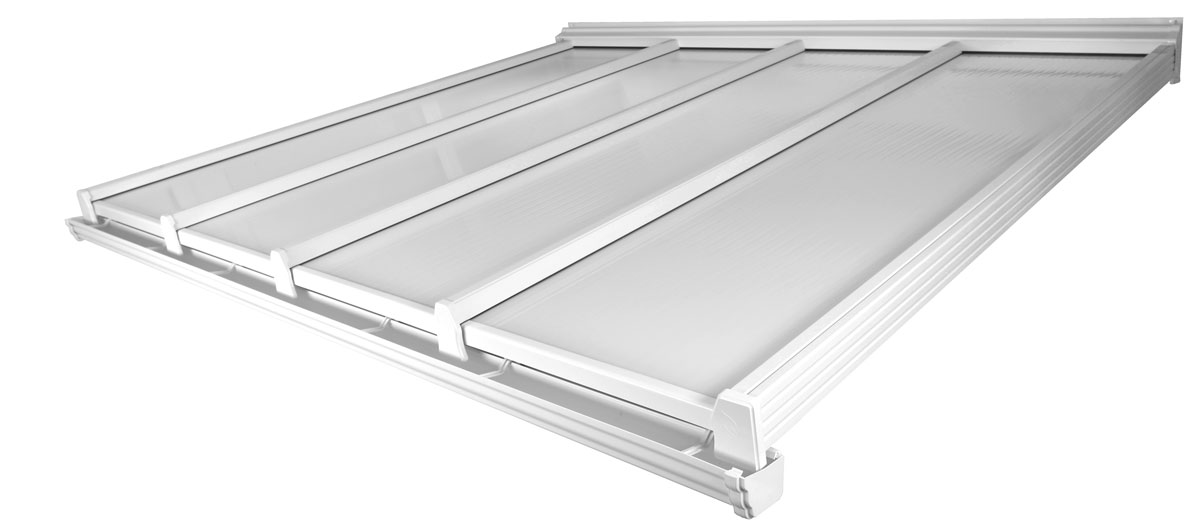Can Polycarbonate Be Recycled?
Is Polycarbonate Recyclable? Sustainability and Environmental Impact Explained

As environmental consciousness grows, more homeowners and builders are questioning the sustainability of their material choices. If you're considering polycarbonate roofing or products, you're likely wondering: Is polycarbonate a sustainable material? Can it be recycled? Let's examine the environmental impact and recyclability of this widely used plastic material.
Before we begin, you should also consider the expected lifespan of polycarbonate, which, when properly maintained, can be 30-40 years.
Understanding Polycarbonate
Polycarbonate is a thermoplastic polymer known for its strength, clarity, and versatility. While it's derived from petroleum-based sources, its environmental story is more nuanced than you might expect.
Yes, Polycarbonate Can Be Recycled
The good news is that polycarbonate is recyclable. It's classified as a #7 plastic (or sometimes marked with the recycling code "PC"), and can be processed and reused to create new products. The recycling process typically involves:
- Collection and sorting of polycarbonate waste
- Cleaning to remove contaminants
- Shredding into small flakes or pellets
- Reprocessing into new polycarbonate products or other materials
Recycled polycarbonate can be used to manufacture a variety of items, including automotive parts and construction materials, thereby reducing the need for virgin plastic production.
The Sustainability Picture
Longevity Reduces Waste
One of polycarbonate's strongest sustainability credentials is its exceptional durability. Quality polycarbonate roofing can last 20-40 years or more with proper maintenance. This longevity results in fewer replacements over time, thereby reducing material consumption and waste generation compared to shorter-lived alternatives.
Energy Efficiency Benefits
Polycarbonate's excellent insulation properties contribute to energy savings throughout its lifespan. By reducing heating and cooling demands, it helps lower your carbon footprint and energy consumption—a significant environmental benefit that extends beyond the material itself.
Lightweight Transportation
Being significantly lighter than glass or traditional roofing materials, polycarbonate requires less fuel for transportation, reducing emissions associated with shipping and delivery.
Challenges and Considerations
Limited Recycling Infrastructure
While polycarbonate is technically recyclable, the reality is more complex. Not all recycling facilities accept polycarbonate, and collection programs vary widely by location. This limited infrastructure means much polycarbonate still ends up in landfills rather than being recycled.
Petroleum-Based Origin
As a plastic derived from fossil fuels, polycarbonate production does have an environmental footprint. However, ongoing research into bio-based polycarbonates shows promise for more sustainable production methods in the future.
Mixed Materials
Polycarbonate products often include UV-protective coatings, additives, or are bonded with other materials, which can complicate the recycling process and reduce recyclability.
Making Polycarbonate More Sustainable
Choose Quality Products
Investing in high-quality polycarbonate with UV protection ensures a longer lifespan, maximising the environmental benefit of durability.
Research Local Recycling Options
Before installation, check with local recycling centres about their ability to process polycarbonate. Some specialised plastics recyclers accept this material even when municipal programs don't.
Consider End-of-Life Planning
Work with manufacturers or suppliers who offer take-back programs or can direct you to proper recycling channels when your polycarbonate roofing reaches the end of its useful life.
Proper Maintenance
Regular cleaning and maintenance extend the life of polycarbonate products, maximising their environmental value by delaying replacement.
Comparing to Alternatives
When evaluating sustainability, it's vital to consider polycarbonate relative to other roofing options:
- vs. Glass: Polycarbonate is lighter (reducing transportation emissions) and less likely to break (reducing waste from damage). Glass in roofing is toughened, and it does not get recycled
- vs. Acrylic: Both are recyclable, but polycarbonate's superior durability may make it more sustainable in the long term, as its expected lifespan is significantly longer.
- vs. Traditional roofing: Polycarbonate's energy efficiency benefits can offset its plastic origins
The Bottom Line
Is polycarbonate perfectly sustainable? No material is without environmental impact. However, polycarbonate offers several sustainability advantages: it's recyclable, exceptionally durable, energy-efficient, and lightweight. The key to maximising its environmental benefits lies in choosing quality products, maintaining them properly, and ensuring proper recycling at the end of life.
As recycling technology improves and bio-based alternatives emerge, polycarbonate's sustainability profile is likely to continue improving. For now, it represents a practical choice that balances performance, longevity, and environmental considerations—especially when compared to less durable alternatives that require more frequent replacement.
When making your decision, consider the full lifecycle impact: production, transportation, energy savings during use, longevity, and end-of-life options. This holistic view will help you make the most environmentally responsible choice for your specific situation.
Aluminium Roof Bars
Recyclability
Both aluminium and polycarbonate are fully recyclable materials. Aluminium is one of the most recycled materials globally and can be recycled indefinitely without losing its properties. Combined with recyclable polycarbonate panels, these systems support circular economy principles.
